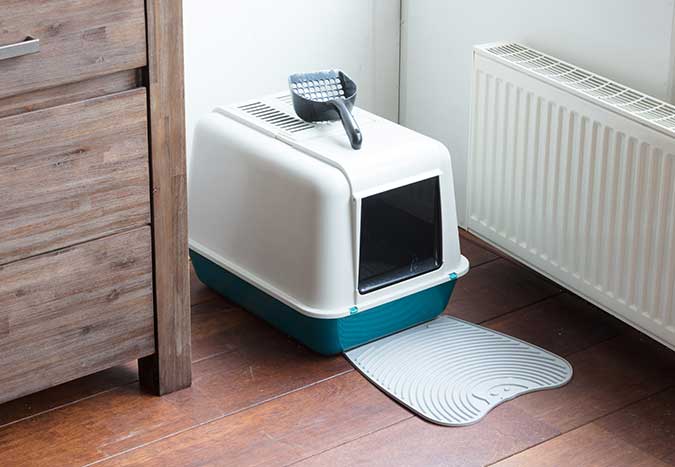Where Should I Put My Cat's Litter Box?

Choosing the perfect spot for your cat's litter box can be a challenge and quite honestly, requires a bit of strategy. After all, you have several things to take into consideration: your cat's needs, your living situation, and the aesthetics of your space. In this article, we're going to discuss where not to put your litter box, as well as the best places you should put your litter box.
WHERE NOT TO PUT THE LITTER BOX
Near Their Food (Or Yours)
Nobody wants to eat near the place where they use the bathroom. Putting your cat's litter box near their food can be very unsanitary, especially since kitty litter may track, spill, and get into your cat's food or water dishes. You also don't want to be smelling odors from the litter box while you're trying to cook dinner, so keeping it out of the kitchen is a wise decision for you both.
High-Traffic Areas
Just like people, cats appreciate some privacy and peace while attending to their business. Avoid putting the litter box in a busy area, such as a foyer or hall, where people are likely to be walking back and forth throughout the day.
Dark or Enclosed Spaces
While private areas are best for your cat to do their business, you don't want to put their litter box in a small, dark space. They will likely feel more vulnerable and on-edge, which will make it more difficult for them to use their litter box.
Near Noisy Appliances
In addition to privacy, cats also appreciate quiet spaces when using the bathroom. While putting the litter box in the laundry room can be an efficient room of the house, the noise of the washing machine and dryer can potentially scare or disrupt your cat while they're trying to go.
Anywhere That's Hard to Access
Do not put your cat's litter box in a place that's hard for them to reach or access, such as in an attic or basement. For those living in a house with multiple floors, does your cat prefer to stay on one level? If so, keep their litter box on the level they stay on so that they won't have to go up or down the stairs to get to it. This is especially helpful for kittens, senior cats, or cats with injuries or limited mobility.
Last of all, it's important to note that you should not move your cat's litter box too often. Even though you might need to relocate it a few times initially to try out the best space, moving the litter box can be stressful and confusing for your cat. Cats love routine, and if their bathroom keeps changing locations, they will likely become anxious. If you do need to move their box, one idea is to move it gradually ( a little at a time each day) so that they don't get confused and will know where to find it.
BEST PLACES TO PUT YOUR CAT'S LITTER BOX

The Bathroom
The bathroom is one of the best places to keep your cat's litter box. Messes will be easier to clean up on the tile or hardwood floor than on carpet. If your home has multiple bathrooms, consider putting the litter box in the bathroom that is used the least. That way, your cat will be able to use it freely without having to wait for you to be done.
A Bedroom
This might not be your first choice, but bedrooms are not a bad option for your cat's litter box. Bedrooms are cozy, comfortable, and private without being too enclosed or crowded. If you're hesitant about keeping a litter box in your room, consider putting it in a spare bedroom instead. Just be sure you always keep the door open.
The Laundry Room
We know, we know. Although we previously mentioned how the laundry room could be potentially distracting and thus an inefficient place to set up the litter box, the laundry room is a popular choice for litter box placement, especially if you have a spacious one. Just be mindful of how often you use your washer and dryer since your cat will likely be scared of the noise. Other than the possible noise issue, the laundry room can be a good space because it is easy to clean and (usually) not too busy.
HOW TO CREATIVELY HIDE YOUR CAT'S LITTER BOX
- Use a hooded litter box: Nobody wants to look down and see an open litter box with used litter in it. Instead, consider getting your cat a hooded litter box to help cover up their mess and smell.
- Drape fabric around an end table: This is an easy way to "hide" your cat's litter box. Consider putting it underneath an end table (if it fits). Next, drape fabric over the top and attach it to the underside of the table so that it both hides the litter box and provides your cat with some privacy. Just make sure your cat can still access it easily.
- Use a bench or toy chest: Storing your cat's litter box inside a bench or toy chest that opens at the top is another good way to keep it out of sight while incorporating it into your home's decor! Again, you'll want to make sure you're using a piece of furniture that the litter box fits inside of. Cut out a door on one or both sides that are large enough for your cat to crawl through. You want this to be a comfortable space for your cat. Be sure to place it somewhere quiet and where they can do their business in peace.
- Build a litter cover: Last of all, if you're looking for a fun DIY project, consider building a litter cover of your own! This way, you can customize it to fit into your space while providing your cat with a bit of privacy.
Additional Resources:
- https://www.thesprucepets.com/litter-box-placement-554839
- https://www.petmd.com/cat/behavior/best-and-worst-spots-your-cats-litter-box
- https://modkat.com/blogs/modkat-purrr/the-9-secrets-to-successful-liter-box-locations
- https://www.rover.com/blog/where-to-put-a-litter-box/
- https://www.thesprucepets.com/clever-ways-to-hide-the-litter-box-4590007
Previous article

Next article

Related posts
View all-

How to Train Your Dog in 2026: A Practical, Step-by-Step Guide
-

Keep Your Pets Safe During the Holidays
The holiday season brings joy, festivities, and a break from the usual routine. While you're enjoying the celebrations, it's important to remember that the holidays can present unique challenges for our furry family members. The new sights, sounds, and people can be overwhelming, and common festive items can pose unexpected risks.
Read Article -

Holiday Gifts for Every Pet Personality: The Ultimate Guide
The holiday season is finally here, and for many of us, that means finding the perfect presents for the ones we love most—our pets. Whether they are a steadfast dog who never leaves your side or an independent cat who graces you with their presence on their own terms, our pets are cherished members of the family. They deserve to celebrate right alongside us, stocking stuffers and all.
Read Article



